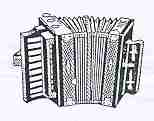
Illustration 15. Vyatskaya harmonika.
(from the archive of A. Mirek)
by Henry Doktorski
© 1998
The American accordion historian, Stanley Darrow, explained, "The early one-row accordions were played in quite a different way compared with today. For the melody, only the three middle fingers of the right hand were used, whereas the thumb was inserted into a loop at the back to steady the instrument. For accompaniment, the second and fourth fingers of the left hand operated bass and chord pallets, while the middle finger controlled the air-release button which released the bellows. The thumb and little finger of the left hand were placed under the instrument. Only around 1840, did the playing of the accordion get nearer to the present way, when it was twisted by about 90 degrees and operated in and out. Slowly the shoulder straps which were non-existent at first, made their appearance."
As mentioned earlier, the first accordions were single-action instruments. Alfred Mirek, the author of Reference Book on Harmonicas, claimed that the first double-action accordion appeared in Russia. He wrote, "In the early 40's, last century, a local model of harmonica [actually a garmonica — an early Russian accordion] began forming in the Vyatskaya province. It was called Vyatskaya. It had sixteen keys in the right keyboard (with the same sound while changing the bellows), and three buttons in the left (basses, chords and a constant sounding piskun). Due to further improvements of Vyatskaya harmonica there was an increase in the number of the reeds: two of them were built an octave higher while two were the basic and the rest one octave lower. Sliding registers (from one to five) were designed on the right side of the instrument."

Monichon, Biannattasio and Bugiolacchi claimed that the first chromatic three-row button-accordion was constructed in 1870 by the Russian musician, N.I. Beloborodov, in Tula. However, Mirek — who is Russian himself — claimed that the first chromatic three-row button-accordion was built in 1891 by G. Mirwald in the city of Zelitue, Bavaria.
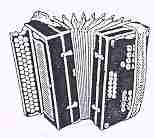
The first patent of an accordion with a piano keyboard was made by M. Bouton of Paris in 1852, but the piano-accordion did not come into popular use until the beginning of the twentieth century. In 1880, an instrument was made by Tessio Jovani in Stradella, Italy which included preset registers with the names of tutti, violina, celesta, flute, organ and tremolo and a bass-chord accompaniment with sixty-four buttons in the left hand.
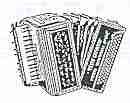
By the last decade of the nineteenth century, the left-hand manual had developed into a complex series of bass and pre-set chord buttons arranged according to the circle of fifths. There were six rows of buttons, consisting of two rows of bass buttons encompassing a range of a major seventh: 1) the counter-bass row (a major third above — or a minor sixth below — the fundamental bass tone), and 2) the bass row (the fundamental); plus four rows of pre-set chord buttons: 1) major, 2) minor, 3) dominant seventh, and 4) diminished. This system eventually became known as the "stradella" system, to differentiate it from the other forms of bass-chord systems which were common at the time.
In 1890 the deluxe model made by Mariano Dallape and company in Stradella Italy, had a right-hand piano keyboard of three octaves and 112 left-hand buttons; according to Mirek, it was considered to be the finest instrument for solo playing.
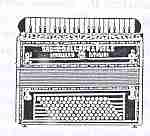
By the beginning of the twentieth-century the accordion finally had evolved into a sophisticated instrument capable of playing in all keys. Composers gradually began to take note of this new improved accordion.
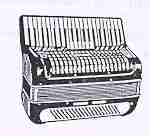
Credit for much of the growth of the classical accordion must go to the Hohner company which began manufacturing accordions shortly after the turn of the century. Wagner wrote, "In the late 1920's, Hohner came up with a new idea for enlarging the market for the instrument. They decided to improve its public image by turning it from a folk instrument played by ear to a respectable instrument played from sheet music. A model 'accordion orchestra' of around thirty skilled amateurs was put together and toured extensively by bus throughout Germany and the neighboring countries presenting the new concept to the public. Hohner also began to publish sheet music of classical pieces and established a college for accordion teachers to 'raise the standard.' The response was enormous."
Hohner's music school, which was established at Trossingen in 1931, became an official state academy in 1948 under the principalship of Hugo Herrmann (1896-1967), who, on the invitation of Ernst Hohner in 1927, composed the first original composition of musical importance for the solo accordion: Sieben neue Spielmusiken, op. 57/1 (Seven New Pieces).
The movements are titled: 1. Wie ein Praeludium, 2. Kleiner Marsch, 3. Langsamer Walzer, 4. Serenade, 5. Lied ohne Worte, 6. Dudelsack-Musette and 7. Harlekinade.
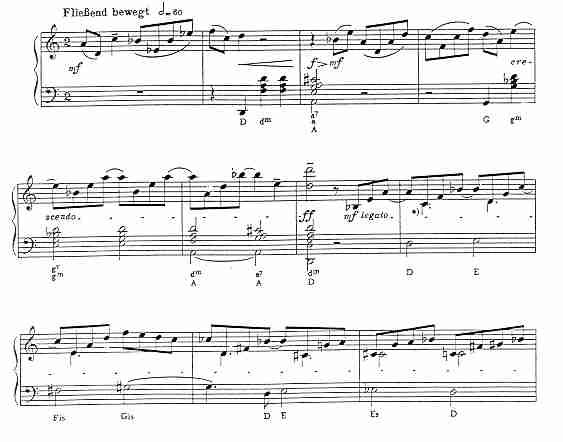
Example 8. Hugo Herrmann, Sieben neue Spielmusiken for solo
accordion, measures 1-11 from the first movement, Wie ein Praeludium.
© 1935. Used by permission of Matth. Hohner A.G.
Herrmann wrote many other pieces for the accordion, including Musikalische Bewegungsspiele, which was written on the occasion of the Olympic Games in 1936 and consisted of five pieces titled: Der Laeufer — Perpetuum mobile, Der Springer — Capriccioso, Der Schwimmer — Tango, Der Ringer — Toccato and Der Sieger — Hymne.
Hermann also wrote Rondoletto (1937), Fruehlingssonatine (1940), Toccata (1942), Kleines Konzert fuer Akkordeon (1943), Five Etudes (1946) and Fuga Chromatica (1946) which were published by Hohner. Soon other German composers followed, such as Hermann Ambrosius, Alfred von Beckerath, Hans Brehme, Hermann Erdlen, Friedrich Haag, Wolfgang Jacobi, Ernst-Lothar von Knorr, Hans Lang, Gerhard Maasz, Ph. Mohler, Walter Rein, Kaspar Roeseling, Josef Schelb, Fritz Stege, Gerhard Strecke, Bruno Sturmer, Eberhard Ludwig Wittmer and Hermann Zilcher.(For more information see http://www.accordion-online.de, Martin Weyde's Site of German Composers Who Wrote for Accordion.)
In addition to solo accordion pieces, Hohner commissioned and published much chamber music with accordion — including seventy-six works for accordion orchestra between 1933 and 1955. In 1983 Walter Maurer listed 287 compositions for accordion orchestra in his book Accordion — Handbuch eines Instruments, seiner historischen Entwicklung und seiner Literatur, the majority of which were written by German composers and published by German music companies such as Matth. Hohner, Josef Preissler, Alfons Holzschuh, Edition Helbling and Sikorski.
Wagner continued, "when the Nazis came to power, the growth of the accordion slowed down. The propagandists claimed that the accordion was a 'nigger jazz instrument' for its close connection with modern American dance music. The Nazis tried to stop accordion bands from playing classical music which for them was an 'abuse of the music of our great masters.' The president of the reichsmusikkammer — the highest institution controlling music in the Third Reich — declared that 'now is the time to build a dam against the flooding of our musical life by the accordion.'"
The decision to eliminate the accordion from Germany was never enforced, however, because the Hohner company made a convincing appeal to the government. Hohner argued that the accordion was a genuine, legitimate instrument and had a large repertoire of authentic German folk music. In addition, they claimed, if the accordion were banned, hundreds and thousands of German music teachers and workers in Hohner factories would lose their livelihoods.
In 1937 two Soviet composers wrote the first concerti for accordion. Feodosy Antonovich Rubtsov (b. 1904) of Leningrad wrote Concerto No. 1 for Bayan (a Russian button-accordion) and Russian Folk Instruments Orchestra, which was the first large-scale piece of art music in the history of the Russian accordion. Almost simultaneously with the concerto by Rubtsov, there appeared a large composition for bayan and symphony orchestra — Concerto by T. Sotnikov, which, however, has left no considerable trace in the history of accordion-playing.
Soon other concerti appeared. In 1940 Hugo Herrmann composed Concerto for Accordion and String Orchestra. In 1942 Hohner published Concerto in B Major by Fred Malige. Herrmann's second concerto followed in 1949 and his third concerto, Double Concerto for Accordion, Harp and Orchestra came in 1951.
In the United States there were three accordionist-composers who more than any other dominated the first half of the twentieth century; they were Pietro Frosini, Pietro Deiro and Anthony Galla-Rini. The first American classical accordion pieces were not written by professional composers, but by accordion vaudeville performers who wanted something more substantial to play.
The Italian-born Pietro Frosini (1885-1951) studied piano, cornet, harmony, counterpoint and composition at the Municipal Conservatory of Fine Arts in Catani Sicily and the Milan Conservatory of Music. He emigrated to the United States in 1905, made his accordion debut at Fresno California, and became a vaudeville star who in 1911 gave a command performance before King George V of England. Frosini wrote approximately 200 original pieces for accordion; most were light and entertaining but some were more serious, like his virtuosic Variations on Carnival of Venice (1938) and Three Rhapsodies (1939).
Pietro Deiro (1888-1954), who also was born in Italy, wrote hundreds of waltzes, marches, polkas and novelties, but also attempted more serious pieces, such as five overtures — Trieste, Aurelia, Imperia, Eternal Spring and Militaire (1929-1945), Six Concert Etudes (1947) and three works for accordion and orchestra: Concerto in D, Concerto in A and Concerto in E. Deiro's Concerto in D (1939) received many performances, including one in 1947 at the Royal Albert Hall in London by the Norwegian accordionist, Toralf Tollefsen. Flynn, Davison and Chavez wrote in The Golden Age of the Accordion, "Affectionately named the daddy of the accordion by his colleagues, Pietro was recognized as a primary force in establishing the popularity of the instrument through out the world."
Anthony Galla-Rini (b. 1904) was one of the world's first "legitimate" accordionists. Although he began performing popular music professionally (sometimes in clown costume and makeup) with his father's touring vaudeville act (known first as the Galla-Rini Four and later as Les Buffons Musicale — The Musical Clowns) at the age of seven years (and therefore could not complete his formal education), his heart was immersed in the classics. Ove Hahn wrote in Anthony Galla-Rini — On His Life and the Accordion: "He [Galla-Rini] started listening to recordings of great artists such as Rachmaninoff, Heifetz, Paderewski and conductors such as Toscanini, Stokowski Koussevitsky. Those musical personalities thus became his 'teachers!' . . . Whenever [his father] John gave Anthony some spending money, he did not buy candies or ice cream, but music!"
Galla-Rini began composing in 1931 and premiered his Accordion Concerto in G Minor with the Oklahoma City University Symphony Orchestra on November 15, 1941. Since then there have been more than thirty-nine performances of this concerto in the United States as well as additional performances in England, Finland, Norway and Canada.
Example 9. Anthony Galla-Rini, Concerto No. 1 in G Minor for
accordion and orchestra,
measures 34-43 of the accordion part from the
first movement — Allegro moderato con passione.
© 1951 by Carl Fischer,
Inc. Copyright renewed. International copyright secured. Used by
permission.
Galla-Rini's second work for accordion and orchestra, Concerto in E minor, was completed in 1976, and his Sonata in D Minor appeared in 1984. Galla-Rini received an entire half-page entry in The New Grove Dictionary of American Music, a standard reference work for libraries in English-speaking countries.
In 1947 the American composer, Roy Harris (1898-1979), commissioned by the Midwest Accordionists' Association, wrote Theme and Variations for accordion and orchestra. It was first performed in a radio broadcast by the American Broadcasting Symphony Orchestra with Andy Rizzo as soloist.
The (http://www.ameraccord.com/comm_wrks.htm) American Accordionists' Association, founded in 1938, commissioned fifty works for the accordion between 1957 and 1995, including Concerto for Accordion and Orchestra (1960) by Paul Creston; Concerto Brevis for Accordion and Orchestra (1961) by Henry Cowell; Night Music for Accordion and String Quartet (1962) by David Diamond; Adagio and Rondo Concertante (1962) for two accordions and orchestra by Paul Pisk; and other works for solo accordion by Robert Russell Bennett, Lucas Foss, Ernst Krenek, Normand Lockwood, Otto Luening, Pauline Oliveros, Wallingford Riegger, William Grant Still, Alexander Tcherepnin and Virgil Thomson, to name a few.
| Back to History of the Free-Reed Instruments |
| Back to The Classical Free-Reed, Inc. Home Page |